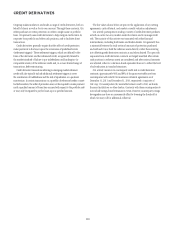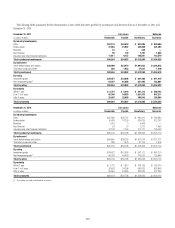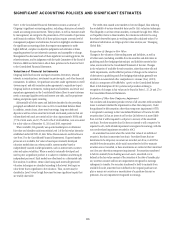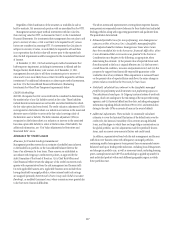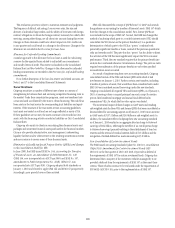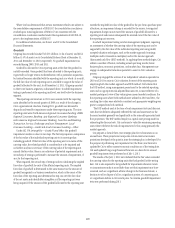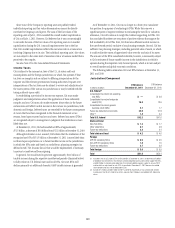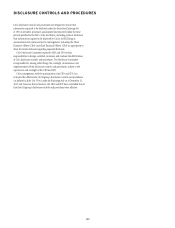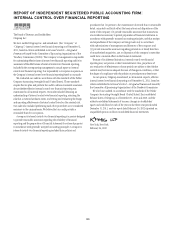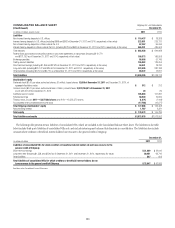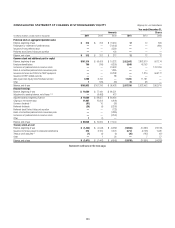Citibank 2011 Annual Report Download - page 146
Download and view the complete annual report
Please find page 146 of the 2011 Citibank annual report below. You can navigate through the pages in the report by either clicking on the pages listed below, or by using the keyword search tool below to find specific information within the annual report.124
FORWARD-LOOKING STATEMENTS
Certain statements in this Form 10-K including but not limited to statements
included within the Management’s Discussion and Analysis of Financial
Condition and Results of Operations, are “forward-looking statements”
within the meaning of the rules and regulations of the SEC. In addition,
Citigroup also may make forward-looking statements in its other documents
filed or furnished with the SEC, and its management may make forward-
looking statements orally to analysts, investors, representatives of the media
and others.
Generally, forward-looking statements are not based on historical facts
but instead represent only Citigroup’s and its management’s beliefs regarding
future events. Such statements may be identified by words such as believe,
expect, anticipate, intend, estimate, may increase, may fluctuate, and
similar expressions, or future or conditional verbs such as will, should,
would and could.
Such statements are based on management’s current expectations and
are subject to uncertainty and changes in circumstances. Actual results
and capital and other financial condition may differ materially from those
included in these statements due to a variety of factors, including without
limitation the precautionary statements included in this Form 10-K, the
factors listed and described under “Risk Factors” above and the factors
described below:
the ongoing potential impact of significant regulatory changes around
the world on Citi’s businesses, revenues and earnings, and the possibility
of additional regulatory requirements beyond those already proposed,
adopted or currently contemplated by U.S. or international regulators;
the uncertainty around the ongoing implementation of The Dodd-Frank
Wall Street Reform and Consumer Protection Act of 2010 (Dodd-Frank
Act), as well as international efforts, on Citi’s ability to manage its
businesses, the amount and timing of increased costs, and Citi’s ability to
compete with U.S. and foreign competitors;
Citi’s ability to meet prospective new regulatory capital requirements in
the timeframe expected by the market or its regulators, the impact the
continued lack of certainty surrounding Citi’s capital requirements has
on Citi’s long-term capital planning, and the extent to which Citi will
be disadvantaged by capital requirements compared to U.S. and non-
U.S. competitors;
the impact of the proposed rules relating to the regulation of derivatives
under the Dodd-Frank Act, as well as similar proposed international
derivatives regulations, on Citi’s competitiveness in, and earnings from,
these businesses;
the impact of the proposed restrictions under the “Volcker Rule”
provisions of the Dodd-Frank Act on Citi’s market-making activities, the
significant compliance costs associated with those proposals, and the
potential that Citi could be forced to dispose of certain investments at less
than fair value;
the potential impact of the newly formed Consumer Financial Protection
Bureau on Citi’s practices and operations with respect to a number of its
U.S. Consumer businesses and the potential significant costs associated
with implementing and complying with any new regulatory requirements;
the potential negative impact to Citi of regulatory requirements in the U.S.
and other jurisdictions aimed at facilitating the orderly resolution of large
financial institutions;
Citi’s ability to hire and retain highly qualified employees as a result of
regulatory requirements regarding compensation practices or otherwise;
the impact of existing and potential future regulations on Citi’s ability
and costs to participate in securitization transactions, as well as the nature
and profitability of securitization transactions generally;
potential future changes to key accounting standards utilized by Citi and
their impact on how Citi records and reports its financial condition and
results of operations, including whether Citi would be able to meet any
required transition timelines;
the potential negative impact the ongoing Eurozone debt crisis could
have on Citi’s businesses, results of operations, financial condition and
liquidity, particularly if sovereign debt defaults, significant bank failures
or defaults and/or the exit of one or more countries from the European
Monetary Union occur;
the continued uncertainty relating to the sustainability and pace
of economic recovery and their continued effect on certain of Citi’s
businesses, particularly S&B and the U.S. mortgage businesses within Citi
Holdings – Local Consumer Lending;
the potential impact of any further downgrade of the U.S. government
credit rating, or concerns regarding a potential downgrade, on Citi’s
businesses, results of operations, capital and funding and liquidity;
risks arising from Citi’s extensive operations outside the U.S., particularly
in emerging markets, including, without limitation, exchange
controls, limitations on foreign investments, sociopolitical instability,
nationalization, closure of branches or subsidiaries, confiscation of assets,
and sovereign volatility, as well as increased compliance and regulatory
risks and costs;
the impact of external factors, such as market disruptions or negative
market perceptions of Citi or the financial services industry generally, on
Citi’s liquidity and/or costs of funding;
the potential negative impact on Citi’s funding and liquidity of a
reduction in Citi’s or its subsidiaries’ credit ratings;
the potential outcome of the extensive litigation, investigations and
inquiries pertaining to Citi’s U.S. mortgage-related activities and the
impact of any such outcomes on Citi’s businesses, business practices,
reputation, financial condition or results of operations;
the negative impact of the remaining assets in Citi Holdings on Citi’s
results of operations and Citi’s ability to more productively utilize the
capital supporting these assets;
the potential negative impact to Citi’s common stock price and market
perception if Citi is unable to increase its common stock dividend or
initiate a share repurchase program;


